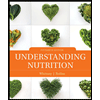
A CASE STUDY
What Is the Female Athlete Triad?
health CONNECTION
Katie Sutton tried out for her school’s dance program at a healthy weight of 130 pounds on her 5’5” frame. The instructors in the dance program suggested that Katie could improve her endurance if she was leaner. Over the next month, Katie added several hours a day of additional exercise to her current dance schedule, while following a very low-calorie diet. By the end of the semester, Katie’s weight had dropped to 105 pounds. Katie’s low-calorie diet and excessive exercise resulted in a stress fracture in her foot that prevented her from performing in the final dance performance of the semester.
The low-calorie diet that Katie followed is one part of the female athlete triad, a syndrome of interrelated conditions existing on a continuum of severity: low energy availability, menstrual dysfunction, and low bone mineral density. Female athletes are often pressured to reach or maintain an unrealistically low body weight and/or level of body fat. This pressure contributes to the development of disordered eating, which helps to initiate the triad. Of major concern with this disorder is that it not only reduces the performance of the athlete, but may have serious medical and psychological consequences later in life.
Components of the Female Athlete Triad
Let’s look at the major components of the triad in a bit more detail.
Low Energy Availability/Disordered Eating
Athletes wishing to lose weight or maintain a low body weight may restrict their energy intake or develop abnormal eating behaviors. At the most extreme, an athlete with disordered eating may fulfill the diagnostic criteria for anorexia nervosa or bulimia nervosa. However, disordered eating occurs on a continuum and is not always so pronounced. Many athletes mistakenly believe that losing weight by any method enhances performance, and that disordered eating is harmless. Disordered eating is most common among athletes in sports where appearance is important, such as figure skating, gymnastics, and ballet, but can occur in athletes in all types of sports. It is also possible for athletes who do not exhibit disordered eating patterns to unintentionally take in fewer calories than they need, such as in Katie’s case. They may appear to be eating a healthy diet—one that would be adequate for a sedentary individual—but their caloric needs are higher due to their level of physical activity.
Menstrual Dysfunction/Amenorrhea
The failure to consume enough energy to compensate for the “energy cost” of the exercise can lead to disruption of the menstrual cycle. At its most extreme and recognizable, this results in amenorrhea, the absence of three or more consecutive menstrual cycles. In Katie’s case, she started to notice irregularities in her period as the semester progressed, but she didn’t know it could be a symptom of a larger problem. Unfortunately, many females welcome the convenience of not menstruating and do not report it.
Low Bone Mineral Density/Osteoporosis
Energy deficiency and decreased estrogen levels due to menstrual dysfunction contribute to bone loss and low bone mineral density. At its most extreme this causes premature osteoporosis, putting the athlete at risk for stress fractures, hip and vertebral fractures, and the loss of bone mass, which may be irreplaceable. Katie’s low-calorie diet, excessive exercise, and menstrual disruption created the conditions that led to the stress fracture in her foot.
Signs and Treatment
All individuals, including friends, teachers, and coaches, involved with female athletes should be aware of the warning signs because the triad components are very often not recognized, not reported, or denied. Warning signs include menstrual changes, weight changes, disordered eating patterns, cardiac arrhythmia, depression, or stress fractures. Those working with athletes should provide a training environment in which athletes are not pressured to lose weight, and should be able to recommend appropriate nutritional, medical, and/or psychological resources if needed. Treatment of an athlete with this disorder is multidisciplinary, and needs to involve cooperation among the athlete’s physician, dietitian, psychologist, coach or trainer, family, and friends.
In Katie’s situation, the symptoms were caught too late and she missed out on the most important performance of the season. However, Katie’s physician recognized the components of the female athlete triad and referred her to a registered dietitian. Katie was able to meet with the registered dietitian, who helped Katie create a more balanced diet to support her level of exercise and help her stress fracture heal. In the future, as Katie continues to eat adequate calories to fuel her body, her estrogen levels should return to normal and her menstrual cycle should regulate, decreasing her risk of any new stress fractures.4,5,6

Female athletes for whom body size or appearance is an issue, such as dancers, gymnasts, and skaters, are often particularly vulnerable to the female athlete triad.
Think About It
What are some strategies that could have been implemented in Katie’s dance program to prevent a situation like this from happening?
Want to see the full answer?
Check out a sample textbook solution
Chapter 11 Solutions
Nutrition & You (4th Edition)
 Understanding Nutrition (MindTap Course List)Health & NutritionISBN:9781337392693Author:Eleanor Noss Whitney, Sharon Rady RolfesPublisher:Cengage Learning
Understanding Nutrition (MindTap Course List)Health & NutritionISBN:9781337392693Author:Eleanor Noss Whitney, Sharon Rady RolfesPublisher:Cengage Learning Nutrition: Concepts and Controversies - Standalo...Health & NutritionISBN:9781305627994Author:Frances Sizer, Ellie WhitneyPublisher:Brooks Cole
Nutrition: Concepts and Controversies - Standalo...Health & NutritionISBN:9781305627994Author:Frances Sizer, Ellie WhitneyPublisher:Brooks Cole- Lifetime Physical Fitness & WellnessHealth & NutritionISBN:9781337677509Author:HOEGERPublisher:Cengage





